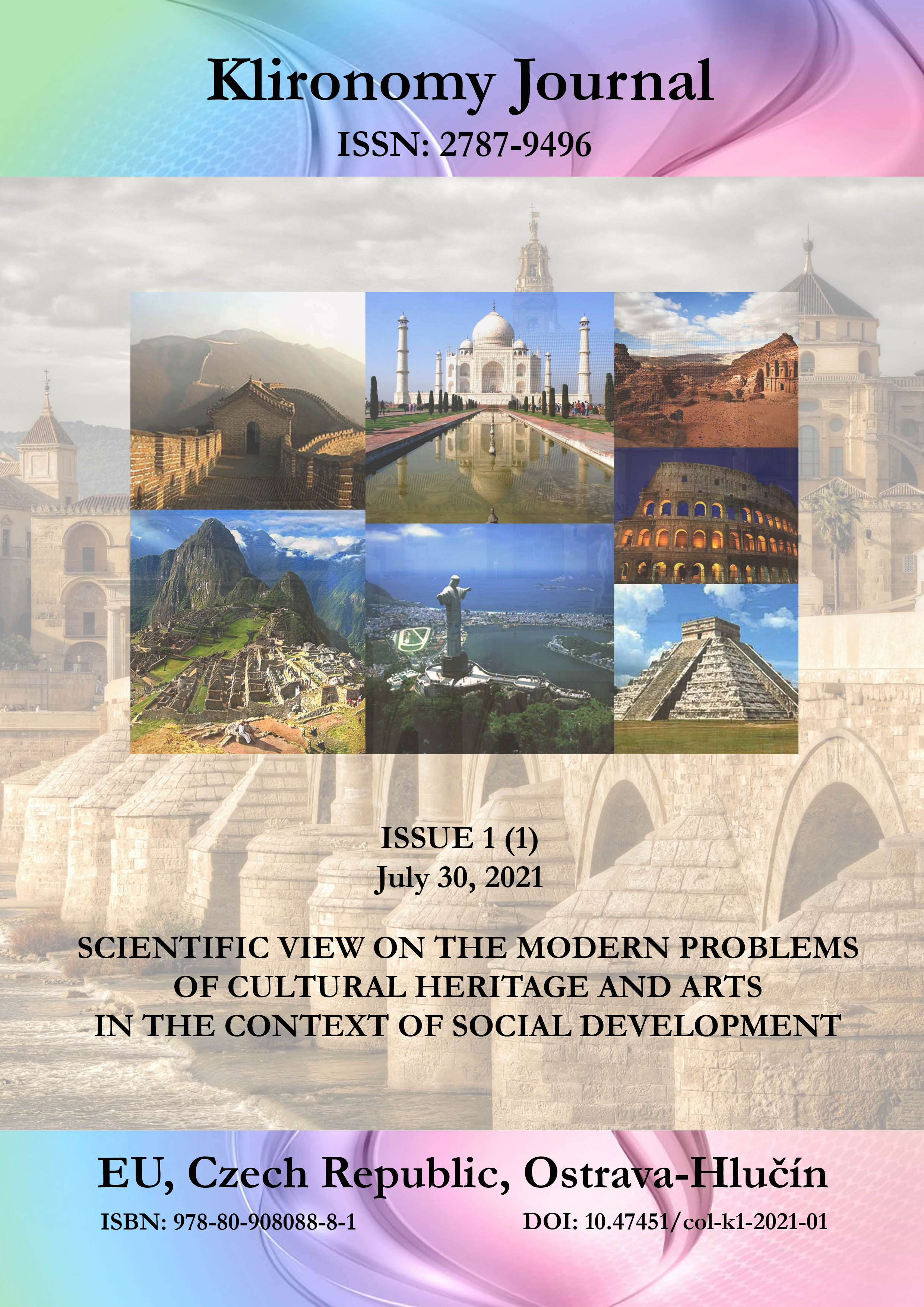The Relevance of the Formation of the Science of the Cultural Heritage Preservation as the Evolution of Social and Scientific Thought
DOI:
https://doi.org/10.47451/her2021-06-001Keywords:
klironomy, cultural heritage preservation, world community, klironomical outlookAbstract
Research in the field of cultural heritage preservation has been actively conducted over the past 150 years. The world community has achieved great success in forming a school of objects’ restoration and conservation of past civilizations’ cultures. However, in the early 21st century, a lot of knowledge began to go beyond what is already available in the classification of the sciences of art and culture. In the last third of the 20th century, a separate science of restoration began to emerge, which is also looking for its place between culture and art. The need to form a new scientific direction on cultural heritage preservation appeared due to the formation of a huge amount of scientific knowledge, which was supported by the evolution of the philosophical thought of the world-leading thinkers, who came close to defining the Concept of Klironomical Outlook, i.e., structural views on determining the value of cultural heritage. The author justifies that the world community has objectively approached the understanding and separation of the klironomical outlook, which contributes to the formation of a new complex of sciences of the cultural heritage preservation—klironomy. The research used the scientific works of the author of the article, as well as leading experts in the field of culture and philosophers.
Downloads
References
Brown, David Alan (1998). Leonardo Da Vinci: Origins of a genius. Yale University Press.
Buychik, A. (2019a). Formation of the concepts of cultural, art history and klironomical outlook as the basis for educating a person of culture and art. The Materials of the International Scientific Forum “Education. Science. Culture”. In 5 parts. Part 2. International Scientific and Practical Conference “Pedagogy and Psychology in the Modern System of Education”: Collection of Scientific Articles, 91–92. Gzhel: GSU. (In Russ.)
Buychik, A. (2019b). Klironomy as a science of preservation of cultural heritage. LAP Lambert Academic Publishing. Mauritius-France-Germany.
Buychik, A. (2021). The formation of klironomical thinking in the system of the social outlook. Eastern European Humanitarian Collection of Mini Monographs. Collection of Scientific Articles. European Scientific e-Journal, 7, 108–154. Hlučín.
Buychik, A. (2014). The story of the restoration of the Great Sphinx in Giza Valley: the relevance of the preservation of world cultural heritage’s monuments. Restoration as the Art of Revival of Historical and Cultural Heritage, 158-170. St. Petersburg: Publishing House “SPbCS”. (In Russ.)
Central State Archive of Moscow. Р-1, op. 1, num. 19. (In Russ.)
Deleuze, G. (2006). Nietzsche and philosophy. Trans. Hugh Tomlinson. Athlone Press.
Flew, A. (1986). David Hume: Philosopher of moral science. Oxford: Basil Blackwell.
Fossi, G. (2013). Uffizi. Florence: Giunti Editore.
Guthrie, W. K. (1979). A history of Greek philosophy. The pre-Socratic tradition from Parmenides to Democritus. Cambridge University Press.
Heese, M. (1968). Francis Bacon’s philosophy of science. In B. Vickers, Essential articles for the study of Francis Bacon. Hamden, CT: Archon Books.
Iglesias, H. (1991). El Palacio Real de Madrid, dos tomos. Madrid: Patrimonio Nacional.
Kelly, E. (2011). Material ethics of value: Max Scheler and Nicolai Hartmann. Dordrecht: Springer.
Kelly, E. (1977). Max Scheler. Chicago.
Kluckhohn, C. (1952). Culture: A critical review of concepts and definitions. Cambridge, Massachusetts.
Kluckhohn, F. R., & Strodtbeck, F. L. (1961). Variations in Value Orientations. Evanston, IL: Row, Peterson.
Lemert, C. (2006). Durkheim’s ghosts: Cultural logics and social things. Cambridge University Press.
Losev, A. F., & Shestakov, V. P. (1965). History of aesthetic categories. Moscow. (In Russ.)
Makovelskiy, A. O. (1946). Greek atomists. Baku. (In Russ.)
Risselada, M., & Heuvel, D. Van den (Eds.) (2005). TEAM 10 – In search of a utopia of the present – 1953-1981. Rotterdam.
Meuthen, E. (2010). Nicholas of Cusa: A sketch for a biography. Washington, DC: The Catholic University of America Press.
Neolithic Tell Ramad. Pre-history and archaeology glossary. http://ancientneareast.tripod.com/Ramad.html
Parsons, T. (1951). The social system. New York: The Free Press.
Perry, R. B. (1926). General theory of value. Cambridge: Harvard University Press.
Rickert, Н. (1929). Wilhelm Windelband. 2. Aufl. Tübingen.
Shook, J. (2000). Dewey’s empirical theory of knowledge and reality. The Vanderbilt Library of American Philosophy.
Ross, Sir D. (1995). Aristotle (6th ed.). Routledge.
Sitwell, C., & Staniforth, S. (Eds.). (1998). Studies in the History of Painting Restoration. Archetype Publications.
Strutin, M. (2001). Discovering Natural Israel.
Taylor, C. C. W. (2001). Socrates: A very short introduction. Oxford: Oxford University Press.
Troitskaya, N. (1926). Museum construction and revolution. Science and Art, 1. (In Russ.)
Vasari, G. (1996). Lives of the painters, sculptors and architects (Vols. I and II). Everyman’s Library.
Yamaki, K. (Ed.). (2001). Nicholas of Cusa: A medieval thinker for the Modern Age. New York: Routledge.
Published
Issue
Section
License
Copyright (c) 2025 Klironomy

This work is licensed under a Creative Commons Attribution 4.0 International License.
The Klironomy is an open access journal. Articles are available free of charge as PDF files on the website of the European Institute for Innovation Development. PDF files can be previewed with Acrobat Reader from www.adobe.com.
All articles of the Klironomy are published under a Creative Commons Attribution 4.0 Generic (CC BY 4.0) International license.
According to the Creative Commons Attribution 4.0 Generic (CC BY 4.0) International license, the users are free to Share — copy and redistribute the material in any medium or format for any purpose, even commercially (the licensor cannot revoke these freedoms as long as you follow the license terms).
Under the following terms:
- Attribution — You must give appropriate credit, provide a link to the license, and indicate if changes were made. You may do so in any reasonable manner, but not in any way that suggests the licensor endorses you or your use.
- No additional restrictions — You may not apply legal terms or technological measures that legally restrict others from doing anything the license permits.





